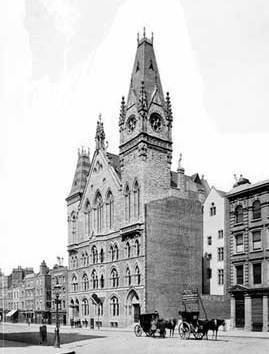Name John Tarring | Died 1875 | |
 | ||
John Tarring FRIBA (1806–1875) was an English Victorian ecclesiastical architect active in the mid-nineteenth century. Based in London, he designed many Gothic Revival churches for Nonconformist clients.
Contents
Life
Tarring was born at Holbeton, near Plymouth, and worked there as a carpenter or plasterer until moving to London in 1828. He studied at Brown's academy in Wells Street, and obtained a Royal Academy medal for a measured drawing. He became a member of the Royal Institute of British Architects in 1845.
Tarring worked principally in London. His firm was variously known as "John Tarring, Esq.," "Tarring & Jones," and "J. Tarring & Son." His son Frederick William Tarring (1847–1925) succeeded him in the business.
Known as the "Gilbert Scott of the Dissenters", he was the first architect to design a spire for a nonconformist church in London, and is thought to have influenced the Baptists and Congregationalists to begin building churches in the Gothic style. Most of his commissions were nonconformist churches, although he had one remodelling commission of an Anglican chapel.
In 1856 he rebuilt George Whitefield's chapel in Tottenham Court Road. The site had recently been bought by the London Congregational Building Society, following the destruction of the existing chapel by fire. Tarring's building had a dome 126 feet (38 m) high. It was closed in 1889 due to subsidence, and later demolished.
Tarring designed at least one church building in Ireland, Trinity Presbyterian Church, Cork, (1861) in a Gothic style with a distinctive spire. The interior has a gallery to the rear with a pipe organ installed there in 1904 and seats for a choir, typical of Roman Catholic churches of the locality, although it may have been intended originally to provide free seating for those unable to afford pew rents; the rest of the interior with a central pulpit, no central aisle and no pillars may reflect Tarring's work on non conformist churches and chapels in the South of England.
Apart from his ecclesiastical work, he restored Combermere Abbey, Cheshire, and Thornton Hall, Buckinghamshire, and designed private residences. At Queen's Gate, Hyde Park, London, in 1860, he built a large mansion block in an Italianate style.
He returned to Devon, and died at Torquay on 27 December 1875. He is buried at Kensal Green Cemetery, London.
